Authentic Niter Kibbeh (Ethiopian Spiced Clarified Butter)
This post may contain affiliate links. See my disclosure policy.
If you love Ethiopian food and just can’t quite figure out how to replicate that flavor at home, you may be missing the ultimate secret ingredient: Niter Kibbeh!
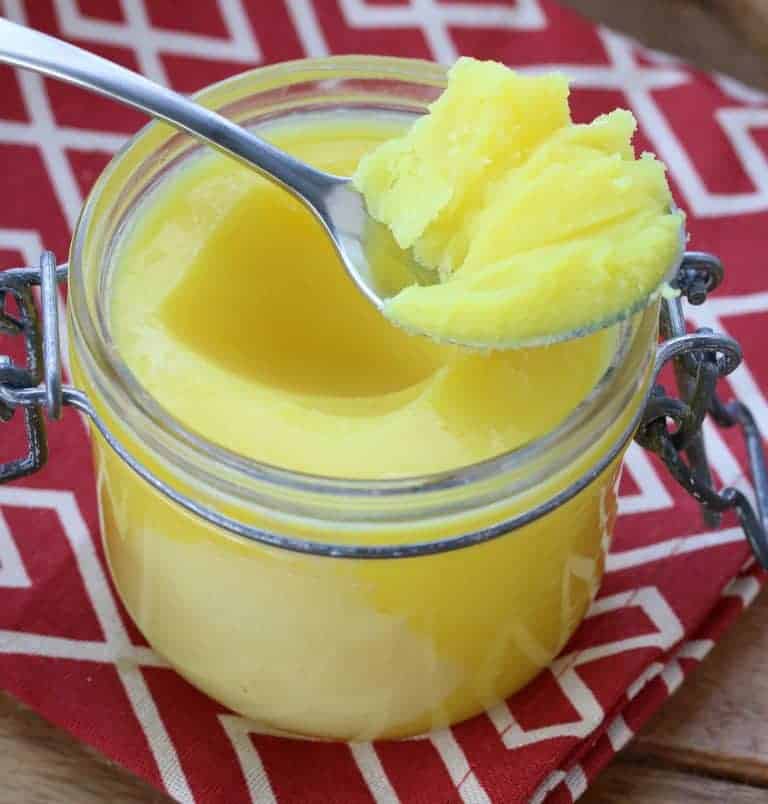
What is Niter Kibbeh?
Niter Kibbeh (Nit’ir Qibe) is an ingredient integral to Ethiopian cuisine and is made by clarifying butter that has been infused with herbs and spices. In the process of clarifying the spiced butter, the same process used to make ghee, the butterfat is separated from the milk solids and water and the result is a highly aromatic and flavorful cooking fat. This clarified butter has a higher smoke point and longer shelf life than regular butter.
How To Use Niter Kibbeh
While niter kibbeh is famously used in Ethiopia’s national dish, Doro Wat, it is highly versatile and used to bring life and flavor to a wide variety of dishes, including Sega Wat, Misir Wat and Gomen. Include a dollop in your favorite stews, your beans and lentils, sauces and gravies, add some to your vegetables and eggs, use it to brown your meat or chicken, spread some on your sandwich…and then sit back and savor your meal.
Ingredients
For a truly authentic niter kibbeh you would include two Ethiopian spices that are very difficult to find outside of Ethiopia: Besobela and Kosseret. Besobela is also known as Ethiopian sacred basil though it tastes nothing like basil. It’s also traditionally included in Berbere, the famous fiery hot Ethiopian spice blend. Kosseret is in the verbena family of plants and likewise has a very unique flavor. There are no adequate substitutes for either. If you can find them, use about a tablespoon of each. If you can’t, simply omit them. The resulting niter kibbeh will still be incredibly delicious without them.
Another central ingredient to niter kibbeh is cardamom. But it’s not the green cardamom that most of us are familiar with. Rather it’s a type of cardamom that’s much bigger in size and is brown in color, known as korarima, false cardamom and Ethiopian cardamom. And it’s tastes completely different than green cardamom.
The bad news is that it’s nearly impossible to find. The good news is that you can substitute Indian black cardamom (pictured below in comparison to the more commonly known green cardamom). It more closely resembles Ethiopian cardamom in flavor than does green cardamom and is an absolutely vital spice in Ethiopian cooking.
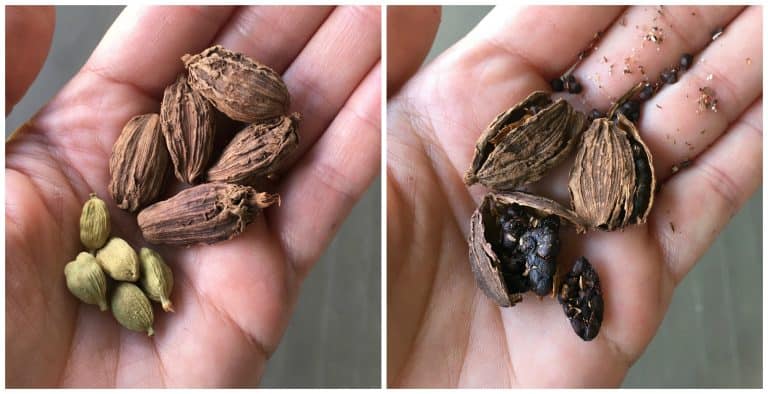
Niter kibbeh is a wonderful and uniquely delicious clarified butter that you will fall in love with. And absolutely nothing compares to homemade niter kibbeh. Once you’ve made it (it’s super easy) and tried it (it’s incredible) you’ll make it again and again!
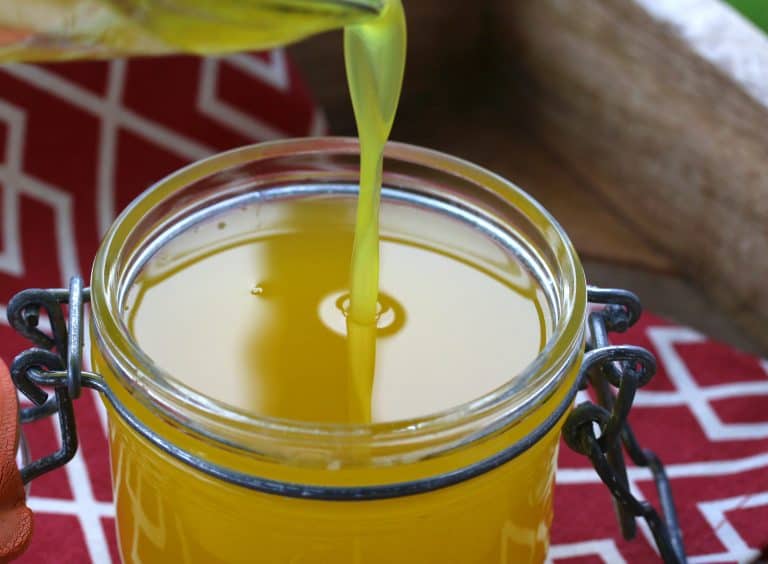
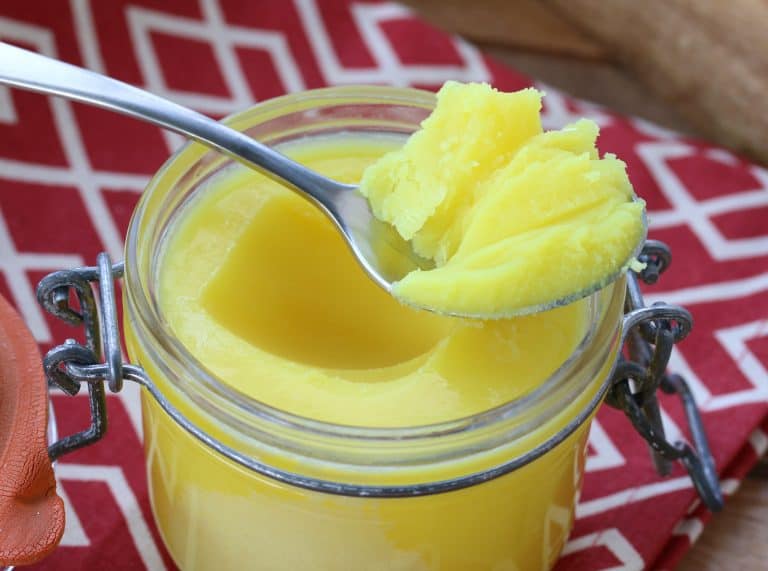
Authentic Niter Kibbeh Recipe
Let’s get started!
Toast the whole spices over medium heat in a dry skillet for a few minutes until very fragrant. Be careful not to scorch the spices or they will become bitter.
Place all the ingredients in a medium saucepan and bring it to an extremely low simmer. Continue to simmer over low for at least one hour or up to 90 minutes. BE VERY CAREFUL NOT TO BURN THE BUTTER. If it burns it will be bitter and there is no salvaging it.
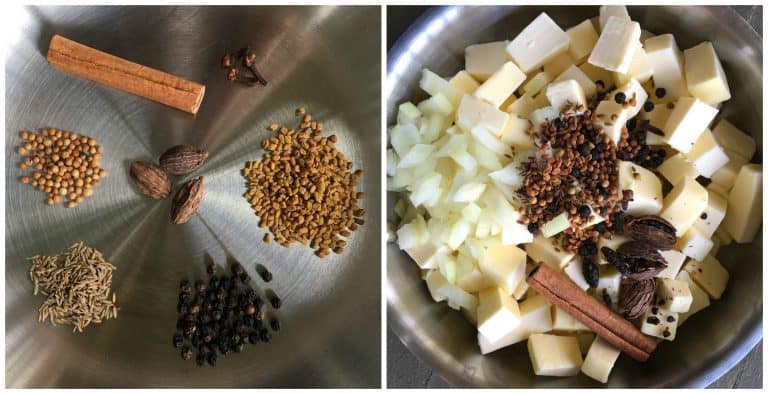

Pour everything through a fine-mesh cheesecloth. (No need to skim off the foam, everything will be removed during straining.)
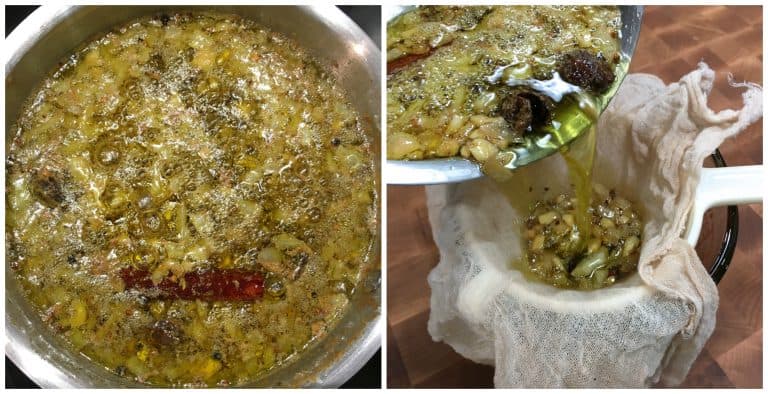
Pour the niter kibbeh into a jar, let it cool, cover so it is airtight. It will keep at room temperature for a few weeks, in the fridge for a few months, and even longer in the freezer (it will be hard in the fridge and freezer, let it come to room temp for easy scooping). Makes about 2 cups.
Enjoy!
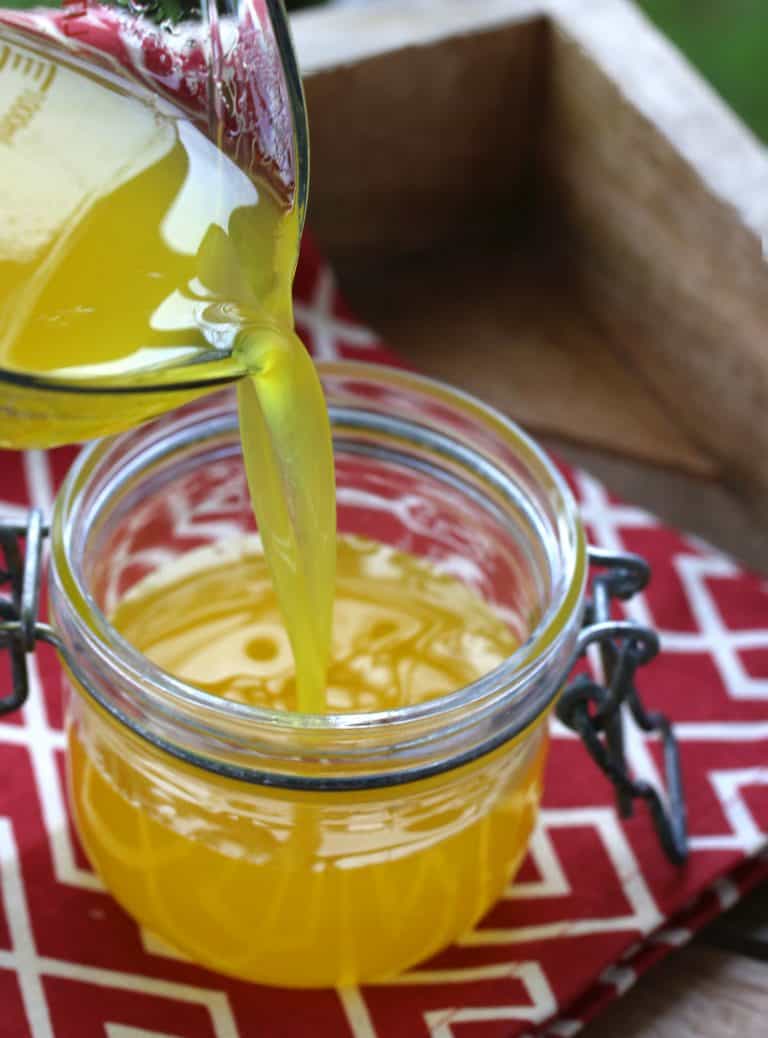
For more delicious and authentic Ethiopian recipes, be sure to try my:
Save This Recipe
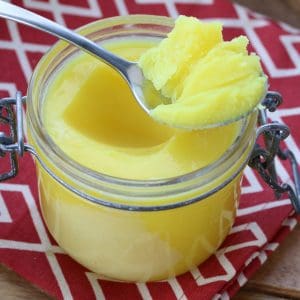
Authentic Niter Kibbeh (Ethiopian Spiced Clarified Butter)
Ingredients
- 1 pound unsalted butter, cubed
- 1/4 cup chopped yellow onion
- 3 tablespoons minced fresh garlic
- 2 tablespoons minced fresh ginger
- 1 2-inch cinnamon stick
- 1 teaspoon whole black peppercorns
- 3 BLACK cardamom pods (not the green cardamom variety)
- 3 whole cloves
- 1 teaspoon fenugreek seeds
- 1 teaspoons coriander seeds
- 1 teaspoon dried oregano
- 1/2 teaspoon cumin seeds
- 1/4 teaspoon ground nutmeg
- 1/4 teaspoon ground turmeric
- 1 tablespoon besobela ,if you can find it, otherwise omit (see blog post)
- 1 tablespoon kosseret ,if you can find it, otherwise omit (see blog post)
Instructions
- Toast the whole spices over medium heat in a dry skillet for a few minutes until very fragrant. Be careful not to scorch the spices or they will become bitter. Set aside.
- Place all the ingredients in a medium saucepan and bring it to an extremely low simmer. Continue to simmer over low for at least one hour or up to 90 minutes. BE VERY CAREFUL NOT TO BURN THE BUTTER. If it burns it will be bitter and there is no salvaging it.
- Pour everything through a fine-mesh cheesecloth. (No need to skim off the foam, everything will be removed during straining.) Pour the niter kibbeh into a jar, let it cool, and cover so that it is airtight. It will keep at room temperature for several weeks, in the fridge for a few months, and even longer in the freezer (it will be hard in the fridge and freezer, let it come to room temp for easy scooping). Makes about 2 cups.



















I’m prepping to make injera and a few other Ethiopian dishes for Thursday’s dinner. I wanted to get a jump start on this. All I can say is wow. This is delicious. I’ve saved a little of the part that didn’t fully clarify to try dipping homemade soft pretzels into tomorrow.
Awesome, Mark, I’m so glad you enjoyed it, thank you!
Thank you for this recipe, which I’ll use for an Ethiopian raw beef dish. I’d like to say for any recipe using fresh ginger instead of dry powdered ginger, it’s very easy to use fresh turmeric root as well, instead of the dried.
I made this recipe using Miyokos ‘butter’ for my vegan daughters and they were ecstatic. It turned out beautifully. We all swooned over that Ethiopian carrot, cabbage, potato dish that is their favorite.
That’s fantastic, Michelle, thank you so much for the feedback!
Hi Kimberly, Thanks a bunch for sharing this recipe. I made a batch today and it turned out awesome! I can’t wait to use it even in other dishes like the Indian Daal. I strained the niter kibbeh using a stainless steel strainer. I used the leftovers from the strained niter kibbeh to make a broth for a curry. I just added 4 cups of water to the pot I made the niter kibbeh in and let the strained stuff boil for 2-3 minutes. Then I strained the broth and will be adding it to the curry I make later! Thanks again!
Thanks so much, Namita, I’m happy you enjoyed it!
The first time I made this I was very pleased. I’ve just made it a second time, though, and it turned brown within twenty minutes on the lowest possible heat setting on the stove. As far as I can remember, here are the only differences: 1) I used shallots instead of yellow onion. 2) I put it on a different burner which possibly gets hotter. 3) I didn’t stir it during those twenty minutes. Was failing to stir it a mistake? If so, how often should it be stirred?
I’m officially obsessed with this and want to make jars for the whole family for Christmas. I can’t help myself from randomly opening the jar and taking in the amazing smell!
Can I triple the recipe or should I stick to making it in 1lb batches? I made it with refined coconut oil as another person suggested and it worked perfectly and since it has a high smoke point I was less worried about burning it (though I was careful to keep the simmer very low regardless).
Fantastic, Hilary, thank you! Tripling it shouldn’t be a problem, just continue to focus on keeping the temp low.
It worked! Took forever to prep that much ginger and garlic but otherwise it turned out great :)
I’ve been making this recipe for about a year now and am totally addicted to it. I found the recipe and started making it for some Ethiopian recipes – but now I use the butter for all kinds of dishes. It adds flavour, depth and warmth for instance to scrambled eggs, or fried mushrooms, fried rice, or a dhal. I keep meaning to make up some different versions using different spices, but in fact, I am so happy with this mix that I’ve not actually bothered. So thank you Kimberly for a much loved added ingredient to my repertoire. (And yes, it keeps for months in the fridge). PS It’s the black cardamoms I think that are really essential.
That’s wonderful, Helen, and I couldn’t agree more about its versatility – thank you so much for the feedback! <3
Perfect blend of spices. I was able to find besobela and kosserot at my neighborhood Ethiopian market. I’ve made this before but it had fewer spices and it was OK, but your recipe is delicious.
I’m so glad, Sheri, thank you for the feedback!
Hiiii i need ethiopan butter pls
Thanks for such a beautifully visual recipe! I understand that the traditional process of making this clarifies regular butter. I was wondering if I could use ghee since I have a lot of it on hand. We’re not buying much new dairy these days…. do you think this would work ok with coconut oil?
Hi Stephanie, yes you can use ghee and heat it up with the spices to infuse it with flavor. You can also use coconut oil, it will just have that coconut flavor of course.
If you coconut oil to produce a vegan friendly product instead of butter use REFINRD coconut oil for a less or no coconuty taste. Use a combination of coconut oil and a neutral tasting oil like canola for a less harder to scoop product right out of the fridge.
Hello! I have not yet tried the recipe but am beyond looking forward to it, had to amass quite the Arsenal of spices to be able to get ready for it! I wanted to update you, the amazon links you shared for the spices is out and they are not going to be restocking, but all the specialty Ethiopian spices are actually stocked by a small spice business in MA that ships nationwide and sells at extremely reasonable spices. They have the korerima, besobela and kosseret. The owner sources from Ethiopia and has an amazing blog detailing her clean sourcing. https: //ww w.curiospice. com/
I accidentally bought salted butter—will this still work?
Hi Diana, yes that will work.
Hello! Would the salted butter change the taste when using in recipes?
Hi Darryl, salted butter is fine. You’ll just want to cut back a bit on the salt in whatever dish you’re using the niter kibbeh. Happy cooking!
Hi,
I was wondering if I could substitute ground cloves and ground cinnamon for the whole ones?
Hi Kristen, using whole spices allows you to strain them out of the clarified butter. Using ground spices will result in dark-colored clarified butter with flecks of spices in it. The issue is mostly aesthetic so if that doesn’t bother you then it’s no problem. But another potential problem could be if you’re using the clarified butter for frying, the ground cloves and cinnamon could potentially scorch and turn bitter. But again, if you’re not frying with it, only light sautéing or just adding it to a dish for flavor then it’s not a problem.
Thanks for your response, Kimberly. I made it and it turned out wonderfully. I did use ground cloves since I did not have whole cloves, but it looked fine, and tasted delicious.
My son’s eyes lit up when I told him that I was preparing to make this again, along with your Doro Wat recipe. Thanks for the great recipes!
That’s wonderful, Kristen, thanks so much for the feedback!
Made the clarified butter and it turned out perfect. I used it in several dishes including yellow lentils and my family was fighting over some taking too much. Thank you for sharing this and other recipes.
That’s wonderful, Alanna, I’m so glad everyone enjoyed it and I appreciate the feedback, thank you!
I made this but was disappointed in the color. But the taste is fabulous.
Could the turmeric have turned it darker than the pictures here?
I sourced the besobela and kosseret and was surprised with the bright smell of the besobela.
I was concerned about “very low simmer” setting. My stove has a low burner mark, but I thought it was too high as I got bubbles all over the surface. Maybe I scorched it a bit? But it’s NOT bitter, it’s all warm flavor and it is great on toast. Even with peanut butter on top!!